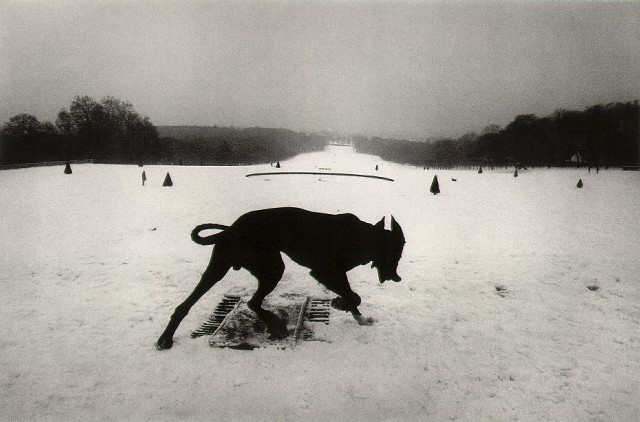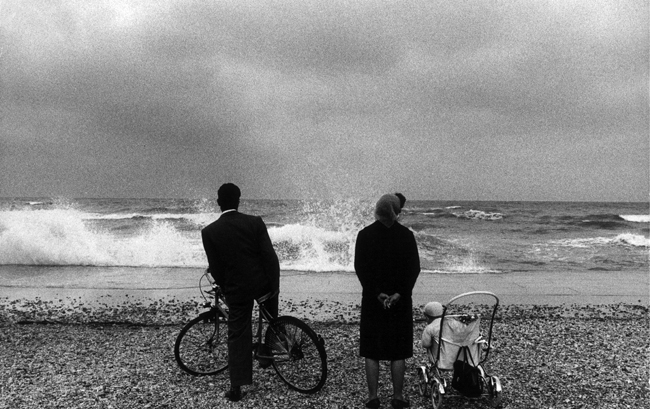

Above are two of my favorite photographs from two of the twentieth century’s most skilled and creative photographers. Both are powerfully evocative while being deceptively banal, commonplace. A dog in a park; a couple with their child at the beach. Both were taken with simple Leica 35mm film cameras and epitomize the traditional Leica aesthetic: quick glimpses of lived life taken with a small, discrete camera, what’s come to be known rather tritely as the “Decisive Moment.”
Looking at them I’m reminded that a definition of photographic “quality” is meaningless unless we can define what make photographs evocative. In the digital age, with an enormous emphasis on detail and precision, most people use resolution as their only standard. Bewitched by technology, digital photographers have fetishized sharpness and detail.
Before digital, a photographer would choose a film format and film that fit the constraints of necessity. Photographers used Leica rangefinders because they were small, and light and offered a full system of lenses and accessories. Leitz optics were no better than its competitor Zeiss, and often not as good as the upstart Nikkor optics discovered by photojournalists during the Korean War. The old 50/2 Leitz Summars and Summitars were markedly inferior to the Zeiss Jena 50/1.5 or the 50/2 Nikkor. The 85/2 and 105/2.5 Nikkors were much better than the 90/2 first version Summicron; the Leitz 50/1.5 Summarit, a coated version of the prewar Xenon, was less sharp than the Nikkor 50/1.4 and the Nikkor’s design predecessor the Zeiss 50/1.5. The W-Nikkor 3.5cm 1.8 blew the 35mm Leitz offerings out of the water, and the LTM version remains, 60 years later, one of the best 35mm lenses ever made for a Leica.
But the point is this: back when HCB and Robert Frank carried a Leica rangefinder, nobody much cared if a 35mm negative was grainy or tack sharp. If it was good enough it made the cover of Life or Look Magazine. The average newspaper photo, rarely larger than 4×5, was printed by letterpress using a relatively coarse halftone screen on pulp paper, certainly not a situation requiring a super sharp lens. As for prints, HCB left the developing and printing to others, masters like my friend and mentor Georges Fèvre of PICTO/Paris, who could magically turn a mediocre negative into a stunning print in the darkroom.
50’s era films were grainy, another reason not to shoot a small negative. Enthusiasts used a 6×6 TLR if they needed 11×14 or larger prints. For a commercial product shot for a magazine spread the choice might be 6×6, 6×7, or 6×9. Many didn’t shoot less than 4×5. If you wanted as much detail as possible, then you would shoot sheet film: 4×5, 5×7 or 8×10.
What made the ‘Leica mystique’, the reason why people like Jacques Lartigue, Robert Capa, HCB, Josef Koudelka, Robert Frank and Andre Kertesz used a Leica, was because it was the smallest, lightest, best built and most functional 35mm camera system then available. It wasn’t about the lenses. Many, including Robert Frank, used Zeiss, Nikkor or Canon lenses on their Leicas. It was only in the 1990’s, with the ownership change from the Leitz family to Leica GmbH, that Leica reinvented itself as a premier optical manufacturer. The traditional rangefinder business came along for the ride, but Leica technology became focused on optical design. Today, by all accounts, Leica makes the finest photographic optics in the world, with prices to match.
Which leads me to note the confused and contradictory soap boxes current digital Leicaphiles too often find themselves standing on. Invariably, they drone on about the uncompromising standards of the optics, while simultaneously dumbing down their files post-production to give the look of a vintage Summarit and Tri-X pushed to 1600 iso. Leica themselves seem to have fallen for the confusion as well. They’ve marketed the MM (Monochrom) as an unsurpassed tool to produce the subtle tonal gradations of the best B&W, but then bundle it with Silver Efex Pro software to encourage users to recreate the grainy, contrasty look of 35mm Tri-X. The current Leica – Leica GmbH – seems content to trade on Leica’s heritage while having turned its back on what made Leica famous: simplicity and ease of use. Instead, they now cynically produce and market status.
For the greats who made Leica’s name – HCB, Robert Frank, Josef Koudelka – it had nothing to do with status. It was all about an eye, and a camera discreet enough to service it. They were there, with a camera that allowed them access, and they had the vision to take that shot, at that time, and to subsequently find it in a contact sheet. That was “Leica Photography.” It wasn’t about sharpness or resolution, or aspherical elements, or creamy bokeh or chromatic aberration or back focus or all the other nonsense we feel necessary to value when we fail to acknowledge the poverty of our vision.
Views: 46869
